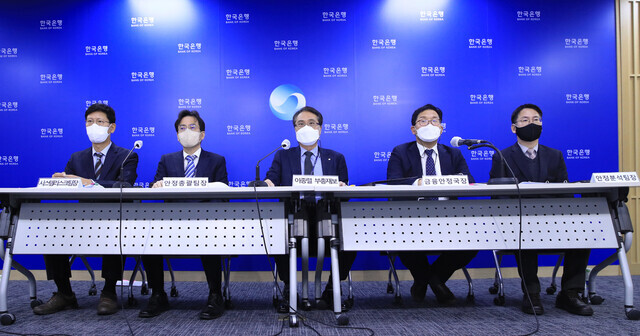hankyoreh
Links to other country sites 다른 나라 사이트 링크
S. Korea’s financial stress index upgraded to crisis level

Korea’s financial stress index (FSI), which shows the state of the short-term vulnerabilities in the domestic financial system, has entered the crisis stage.
The situation has taken a sharp turn for the worse this year due to the steep rise in interest and exchange rates, as well as the ramifications dealings around Legoland in Gangwon Province have had on the bond market.
This means that the financial system is more vulnerable to external forces, which is only causing more concern as monetary tightening and the slowdown of the economy are expected to continue next year.
The Bank of Korea cites the possibility of a hard landing in the real estate market as the main risk factor for next year.
According to the Financial Stability Report for the second half of the year released by the Bank of Korea on Thursday, the FSI has moved from the warning stage to one of crisis, rising from 13.1 in May to 23.6 in October.
The FSI uses 20 monthly indicators in financial and real assets sectors to give a numerical measure of the financial system’s short-term instabilities. The threshold for what the central bank calls a “crisis stage” is 22.
October’s FSI of 23.6 is the second-highest number to date, the highest being 24.7 during the early days of the COVID-19 pandemic. The number fell slightly to 23.0 last month when the government and the Bank of Korea took measures to stabilize the market.
Financial instability is getting rapidly worse due to the won-dollar exchange rate, which climbed as high as 1,400 won, and the bond situation touched off by Legoland in Gangwon Province.
The won-dollar exchange rate rose to 1,400 won to the dollar in September due to the US Federal Reserve’s “giant steps” of raising key interest rates by 0.75 percentage points. The dollar’s sudden surge in value hurt the liquidity of financial institutions, which in turn affected the market, the Bank of Korea explained.
At the end of that same month, liquidity dried up dramatically as investor sentiment froze in the bond market and short-term financial markets due to the Legoland crisis.
The exchange rate and the bond market have recently regained some stability, but if the real estate market does make a hard landing next year, financial instability will grow even worse.
The Bank of Korea believes that financial institutions have enough capital, but if real estate prices fall too quickly, household debt may become insolvent. The soundness of some financial institutions may take the brunt of this, which will lead to a crisis, according to the central bank.
In particular, as housing finance accounts for a large portion of the domestic financial system, the fallout will be significant.
However, the Bank of Korea did also point out that vulnerability is improving in the mid- to long-term. If household debt rose sharply while asset prices soared during the period of near-zero interest, causing vulnerability to increase, this time, the bubble in housing prices has subsided, which reduces sensitivity to external factors.
In fact, Korea’s financial vulnerability index (FVI), which examines asset prices, debt levels and financial systems’ resilience in the mid- to long term, peaked at 58.5 in the second quarter of 2021 and then fell to 44.9 in the third quarter of 2022.
By Lee Jae-yeon, staff reporter
Please direct questions or comments to [english@hani.co.kr]

Editorial・opinion
![[Editorial] Intensifying US-China rivalry means Seoul must address uncertainty with Beijing sooner than later [Editorial] Intensifying US-China rivalry means Seoul must address uncertainty with Beijing sooner than later](https://flexible.img.hani.co.kr/flexible/normal/500/300/imgdb/original/2024/0517/8117159322045222.jpg) [Editorial] Intensifying US-China rivalry means Seoul must address uncertainty with Beijing sooner than later
[Editorial] Intensifying US-China rivalry means Seoul must address uncertainty with Beijing sooner than later![[Column] When ‘fairness’ means hate and violence [Column] When ‘fairness’ means hate and violence](https://flexible.img.hani.co.kr/flexible/normal/500/300/imgdb/original/2024/0516/7417158465908824.jpg) [Column] When ‘fairness’ means hate and violence
[Column] When ‘fairness’ means hate and violence- [Editorial] Yoon must stop abusing authority to shield himself from investigation
- [Column] US troop withdrawal from Korea could be the Acheson Line all over
- [Column] How to win back readers who’ve turned to YouTube for news
- [Column] Welcome to the president’s pity party
- [Editorial] Korea must respond firmly to Japan’s attempt to usurp Line
- [Editorial] Transfers of prosecutors investigating Korea’s first lady send chilling message
- [Column] Will Seoul’s ties with Moscow really recover on their own?
- [Column] Samsung’s ‘lost decade’ and Lee Jae-yong’s mismatched chopsticks
Most viewed articles
- 1For new generation of Chinese artists, discontent is disobedience
- 2[Editorial] Transfers of prosecutors investigating Korea’s first lady send chilling message
- 3[Exclusive] Unearthed memo suggests Gwangju Uprising missing may have been cremated
- 4[Editorial] Intensifying US-China rivalry means Seoul must address uncertainty with Beijing sooner t
- 5S. Korea “monitoring developments” after report of secret Chinese police station in Seoul
- 6N. Korean media upgrades epithet for leader’s daughter from “beloved” to “respected”
- 7Yoon says concern about biased diplomacy is being incited by “communist totalitarian forces”
- 8[Column] US troop withdrawal from Korea could be the Acheson Line all over
- 9Xi, Putin ‘oppose acts of military intimidation’ against N. Korea by US in joint statement
- 1060% of young Koreans see no need to have kids after marriage